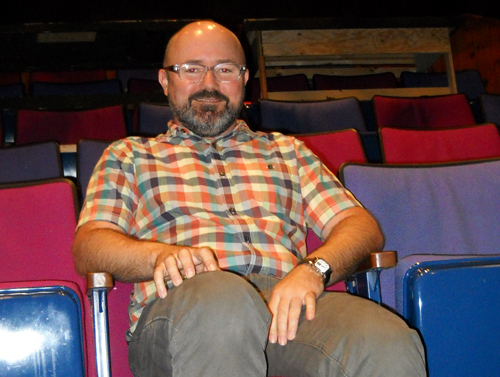
Ideas, information and, yes, scandal, all circulating within a tight network of connected people: We’re talking about social media, right? Well, yes, except that you have to scroll back to Georgian-era London to see what Prof. Daniel O’Quinn is studying at U of G.
No Internet. No iPhones. No Instagram, Facebook or Twitter-verse. But other forms of information and communication fed the flame for society moths in the late 1700s and early 1800s.
A professor in the School of English and Theatre Studies, O’Quinn received $175,000 last fall to study mediation of ethnicity in London during the reign of King George III. His Insight Grant from the Social Sciences and Humanities Research Council was among 10 project grants at Guelph announced by the agency last fall.
Today we rely on an endless loop connecting news and entertainment, much of it online and ever-mutating. Media convergence is second nature for us, says O’Quinn.
In the mid-1700s, commercial theatre as we know it and the modern newspaper developed over a short period, he says. “Many of the most important cultural figures of the day were intimately involved in both media.”
Both theatres and newspapers of the 18th and early 19th centuries relied on each other for content or what he calls social intelligence: “There’s this tight loop of information. Plays regularly integrated the morning’s news into performance, and the papers always discussed what happened last night in the playhouse.”
What happened in the playhouse was a performance in more than one sense.
“The two licensed theatres, Drury Lane and Covent Garden, were among the only spaces in London where people of different ranks and backgrounds interacted with one another. The theatre was fully lit, and playgoers were often more attentive to the social performance around them than to the play itself.”
Social conflicts played out on the stage and in the press, reinforcing identities and social relations in a highly responsive way. O’Quinn says these convergent media helped fuel ethnic violence in the late 18th century.
He’s looking at a number of high-profile examples, including Wilkite reform and anti-Scots rhetoric in the 1760s and ’70s.
The Gordon riots of 1780 were an anti-Catholic protest against the Papists Act. The act was intended to reduce official discrimination against Roman Catholics in Great Britain. But mobs rioted and looted and marched on Parliament, incited by groups including the Protestant Association of London led by Lord George Gordon.
In the mid-1790s, radical attempts to “steal” plays from the repertoire were co-ordinated with complex acts of social insurgency, says O’Quinn.
In 1809, higher ticket prices at Covent Garden sparked more than 60 nights of continuous rioting by patrons. Protesters demonstrated during performances, fuelled partly by repeated newspaper reports. When the theatre manager hired Jewish boxers to quell the unrest, the incident “became a defining moment in the history of British anti-Semitism.”
Violence in the streets affected theatrical and journalistic representation, and performances and stories in turn influenced events.
By looking at newspapers and theatre memorabilia of the day, O’Quinn hopes to learn more about how writing and performance helped cement ethnicity and ethnic relations during this volatile period.
He says the project resonates with modern-day examples.
Media faced criticism for their coverage of the 2012 shooting of Trayvon Martin in Florida, a case that raised concerns over race relations in the United States. This past summer, George Zimmerman was acquitted of second-degree murder and manslaughter.
Says O’Quinn, “The case spiraled insanely out of control because of the way it was mediated.”
Looking back to the Georgian era, he says most researchers have focused on either news or entertainment. He’s interested in seeing how both sides fed off of each other.
He and grad students will use online resources to study pertinent materials, including theatre reviews printed in the papers. Among resources are the Robarts Library at the University of Toronto, the British Library, the Victoria and Albert Museum, and the Huntington Library in California.
O’Quinn has looked at other historical events with modern subtexts.
His analysis of early British critiques of the East India Company’s activities in South Asia – explored in his book Staging Governance: Theatrical Imperialism in London — found echoes in the American invasion of Iraq in 2003. Looking at the complex legacy of the American Revolution in Britain in Entertaining Crisis in the Atlantic Imperium evokes American political self-perception since 9/11.
The scope is narrower with O’Quinn’s current project. But he says modern-day struggles over ethnicity and identity are no less important.